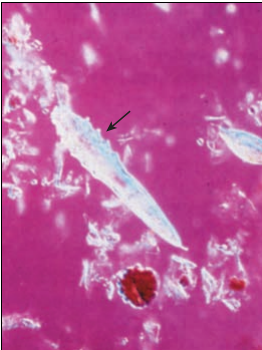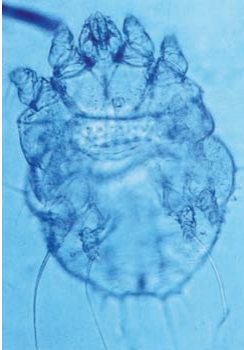Order Opiliones: Harvestmen
Harvestmen, often known as “daddy longlegs,” are common throughout the world and comprise about 5000 species. They are easily distinguished from spiders: their abdomen and cephalothorax are rounded and broadly joined, without the constriction of a pedicel; their abdomen shows external segmentation; and they have only two eyes, mounted on a tubercle on their cephalotho rax. They have four pairs of long, spindly legs that end in tiny claws. They can cast off one or more of these legs without apparent ill effect if they are grasped by a predator (or human hand). The ends of their chelicerae are pincer like, and, while carnivorous, they are often scavengers as well.

the mother until their first molt. B, Harvestmen, Mitopus sp. (order Opiliones). Harvestmen
run rapidly on their stiltlike legs. They are especially noticeable during the harvesting
season, hence the common name.
Harvestmen are not venomous and are harmless to humans. Odoriferous glands that open on the cephalothorax deter some predators with their noxious secretions. Other than some mites, opilionids are unique among arachnids in having a penis for direct sperm transfer; all are oviparous. Traditionally allied with Acari, more recent studies indicate that Opiliones forms a clade with scorpions and two smaller orders. They are the sister group of scorpions.
Order Acari: Ticks and Mites
Members of order Acari are without doubt the most medically and economically important group of arachnids. They far exceed other orders in numbers of individuals and species. Although about 40,000 species have been described, some authorities estimate that from 500,000 to 1 million species exist. Hundreds of individuals of several species of mites may be found in a small portion of leaf mold in forests. They occur throughout the world in both terrestrial and aquatic habitats, even extending into such inhospitable regions as deserts, polar areas, and hot springs. Many acarines are parasitic during one or more stages of their life cycle. Most mites are 1 mm or less in length. Ticks, which are only one suborder of Acari, range from a few millimeters to occasionally 3 cm. A tick may become enormously distended with blood after feeding on its host.
Acarines differ from all other arachnids in having complete fusion of the cephalothorax and abdomen, with no sign of external division or segmentation. They carry their mouthparts on a little anterior projection, the capitulum, which consists mainly of the feeding appendages surrounding the mouth. On each side of their mouth is a chelicera, which functions in piercing, tearing, or gripping food. The form of the chelicerae varies greatly in different families. Lateral to the chelicerae is a pair of segmented pedipalps, which also vary greatly in form and function related to feeding. Ventrally the bases of the pedipalps fuse to form a hypostome, whereas a rostrum, or tectum, extends dorsally over their mouth. Adult mites and ticks usually have four pairs of legs, although there may be only one to three in some specialized forms.

Most acarines transfer sperm directly, but many species use a spermatophore. A larva with six legs hatches from the egg, and one or more eight-legged nymphal stages follow before the adult stage is reached.
Many species of mites are entirely free-living. Dermatophagoides farinae (Gr. dermatos, skin, + phago¯, to eat, + eidos, likeness of form) and related species are denizens of house dust all over the world, sometimes causing allergies and dermatoses. There are some marine mites, but most aquatic species live in freshwater. They have long, hairlike setae on their legs for swimming, and their larvae may be parasitic on aquatic invertebrates. Such abundant organisms must be important ecologically, but many acarines have more direct effects on our food supply and health.

Spider mites (family Tetranychidae) are serious agricultural pests on fruit trees, cotton, clover, and many other plants. They suck the contents of plant cells, producing a mottled appearance on the leaves, and construct a protective web from silk glands opening near the base of the chelicerae. Larvae of genus Trombicula are called chiggers or redbugs. They feed on the dermal tissues of terrestrial vertebrates, including humans, and may cause an irritating dermatitis, but they do not burrow or remain attached to the host. Some species of chiggers transmit a disease called Asiatic scrub typhus. Hair follicle mites, Demodex, are apparently non pathogenic in humans; they infect most of us although we are unaware of them. In some cases they may produce a mild dermatitis. Other species of Demodex and other genera of mites cause mange in domestic animals.


follicle mite.
Human itch mites, Sarcoptes scabiei, cause intense itching as they burrow beneath the skin. Infestations of these mites were very common during World War II because of the crowded conditions underwhich people were forced to live.

itch mite.
The inflamed welt and intense itching that follows a chigger bite is not the result of the chigger burrowing into the skin, as is popularly believed. Rather a chigger bites through the skin with its chelicerae and injects a salivary secretion containing powerful enzymes that liquefy skin cells. Human skin responds defensively by forming a hardened tube that the larva uses as a drinking straw and through which it gorges itself with host cells and fluid. Scratching usually removes the chigger but leaves the tube, which is a source of irritation for several days.
In addition to disease conditions that they themselves cause, ticks are among the world’s premier disease vectors, ranking second only to mosquitos. They surpass other arthropods in carrying a great variety of infectious agents including apicomplexans, rickettsial, viral, bacterial, and fungal organisms. Species of Ixodes carry the most common arthropod-borne infection in the United States, Lyme disease (see note). Species of Dermacentor and other ticks transmit Rocky Mountain spotted fever, a poorly named disease because most cases occur in the eastern United States. Dermacentor also transmits tularemia and agents of several other diseases. Texas cattle fever, also called red-water fever, is caused by a protozoan parasite transmitted by cattle ticks, Boophilus annulatus. Many more examples could be cited.

cattle fever.
An epidemic of arthritis occurred in the 1970s in the town of Lyme, Connecticut. Subsequently known as Lyme disease, it is caused by a bacterium and carried by ticks of the genus Ixodes. There are now thousands of cases a year in Europe and North America, and other cases have been reported from Japan, Australia, and South Africa. Many people bitten by infected ticks recover spontaneously or do not get the disease. Others, if not treated at an early stage with appropriate antibiotics, develop a chronic, disabling disease.
Useful External Links


